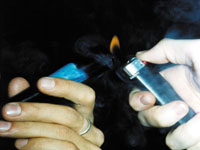- THC & Law:
Table of Contents
Why were there so many hemp stores in the past?
The consumers need the "dealers
Consumers have to get their substance from somewhere. Most of them can't keep themselves at the necessary THC level with home-grown stuff. And they also exist, the sellers.
Until the mid-1990s, the trade was organized both on the street and in private. There was practically only imported hashish on the black market. The proportion of weed was still very low, and indoor was rarely an issue.
From the mid-1990s, more and more people, mainly men between 25 and 40, began to open hemp stores. Some sold the full range of products that the hemp plant had to offer: Clothes, cooking oil, paper, cat litter, roasted hemp seeds and much more.
Most also sold, some even exclusively, hemp herb - some with seeds, some in excellent quality for smoking. Some limited themselves to Swiss outdoor hemp, others also offered indoor goods (imported or already grown in Switzerland).
No hashish
Hashish, on the other hand, was only sold by very few in the stores. At weed there used to be this unclear legal wording “for the production of narcotics”, which made weed legal and illegal at the same time. A special wording in the law that never applied to hashish (and nowadays no longer applies to weed - now everything with more than 1.0% THC is an illegal narcotic).
This legal loophole made the whole hemp store story possible. Hemp herb was offered as a bath additive, as scented sachets, as decorative flowers and not “for the production of narcotics” - and was therefore quasi legal.
Unclear legal situation
The police and the investigating authorities were also initially undecided about how to deal with this particular situation. So at first they let the stores operate, perhaps stopping by once without any obligation. Only gradually did they make raids, confiscate material and interrogate the operators and employees.
But everything was still pretty easy, even after the first raid, business could continue. And so hemp store after hemp store opened. The quality of the flowers increased from year to year, because the farmers also realized that there was a product they could sell at a good price without any subsidies.
Parallel to the rise of the hemp stores, the business on the street went to ruin. Nobody wanted to buy the mostly bad hash anymore - cannabis sales on the street collapsed completely during the heyday of the stores.
The stores on a platter
Since the stores were meant to be legal stores, they paid VAT on the turnover and all the social contributions on the wages. They paid tax on their profits and kept accounts, so they were very open about their business. It was also clear what quantities they were turning over - and the state was happy to accept the millions from the hemp stores. But the same state then massively punished these traffickers, who had built up a flourishing industry, at least in the short term - and without thanks for the millions they had made.
Here follows the corresponding "old" text, which was valid until 30.6.2011.
Why were there so many hemp stores in the past?
The consumers need the "dealers
Consumers have to get their substance from somewhere. Most of them can't keep themselves at the necessary THC level with home-grown stuff. And they also exist, the sellers. Until the mid-1990s, the trade was organized both on the street and in private. From the mid-1990s, more and more people, mainly men between 25 and 40, began to open hemp stores. Some sold the whole range of products that the hemp plant has to offer: Clothes, cooking oil, paper, cat litter, roasted hemp seeds and much more. Most also sold, some even exclusively, hemp herb - some with seeds, some in excellent quality for smoking. Some limited themselves to Swiss outdoor hemp, others also offered indoor goods (imported or already grown in Switzerland).
No hashish
Hashish, on the other hand, was sold by very few. As we will see in the part about the laws, hashish already as a substance is always an (illegal) narcotic according to the Narcotics Law. Leaves, flowers, stems and seeds, on the other hand, are only illegal if they are used to obtain narcotics. From this, first a few, then more and more concluded that hemp herb as a bath additive, as a scented sachet, as decorative flowers is just not “intended for the production of narcotics” - and therefore legal.
Unclear legal situation
The police and the investigating authorities were also initially undecided about how to deal with this new situation. So at first, they let the stores operate, perhaps stopping by once without any obligation. Only gradually did they make raids, confiscate material and interrogate the operators and employees. But everything was still pretty easy, even after the first raid, business could continue. And so hemp store after hemp store opened. The quality of the flowers increased from year to year, because the farmers also realized that there was a product they could sell at a good price without any subsidies. Parallel to the rise of the hemp stores, the business on the street went to ruin. Nobody wanted to buy the mostly bad hash anymore - cannabis sales on the street collapsed completely during the heyday of the stores.
The stores on a platter
Since the stores were meant to be legal stores, they paid VAT on the turnover and all the social contributions on the wages. They paid tax on their profits and kept accounts, so they were very open about their business. It was also clear what quantities they were turning over - and the state was happy to accept the millions from the hemp stores. But the same state then massively punished these traffickers, who had built up a flourishing industry, at least in the short term - and without thanks for the millions they had made.
Nowadays, there are no more hemp stores. There are paraphernalia stores that sell smoking paraphernalia and there are grow stores that sell paraphernalia for growing. But these are, in the vast majority of cases, legal stores that do not sell products containing THC.
Support our work with a donation:
Bank transfer
Account number (IBAN):
CH02 0900 0000 8709 1354 3
Full account details
Or scan this QR code with your eBanking App (ZKB, Revolut, Postfinance, …):

Or open/share the QR code as PDF file with your eBanking App.
Credit card
Donate via credit card
Verein Legalize it!
Quellenstrasse 25
8005 Zürich
Threema ID 7NH65RBY
Don’t miss anything! Follow us on social media:

